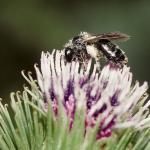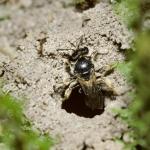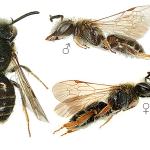Andrena lucens IMHOFF 1866
A small, shining black bee with narrow apical bands of white hairs on the abdominal tergites. Identification characters are in Perkins (1919).
Restricted to the southern counties of England, where it is very local. Widespread in central and southern Europe, central Asia eastwards to Japan and western north Africa.
This species is listed as Rare (RDB3) in both Shirt (1987) and Falk (1991). Work for this atlas suggests that the status should be reviewed.
May be found in a variety of open habitats with a preference for clay-based soils though these need not be acidic. Coastal habitats include unstable undercliffs and vegetated shingle.
Univoltine; June to September
May nest singly or in aggregations in patches of bare clay soil exposed to the sun.
Those of a wide range of plants in the family Apiaceae.
The very rare (RDB 1 Endangered) bee Nomada errans is cleptoparasitic on A. nitidiuscula. However, in Britain there appear to be large populations of A. nitidiuscula where Nomada errans is absent. Numerous Nomada rufipes, which may also be a parasite, have been observed flying over a large nesting aggregation of this Andrena on Salisbury Plain, Wiltshire (G R Else & S P M Roberts, pers. comm. 1999).
2002




